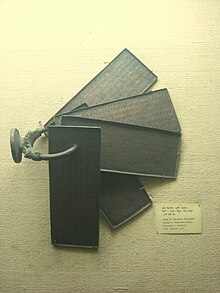Eastern Chalukyas
Subsequently, they became a sovereign power, and ruled the Vengi region of present-day Andhra Pradesh until c. 1001 CE.The Badami ruler Pulakeshin II (610–642 CE) conquered the Vengi region in eastern Deccan, after defeating the remnants of the Vishnukundina dynasty.[15] In its early life, the Eastern Chalukya court was essentially a republic of Badami, and as generations passed, local factors gained in strength and the Vengi monarchy developed features of its own.The inscriptions refer to the traditional seven components of the state (Saptanga), and the eighteen Tirthas (Offices), such as:[18] No information is available as to how the work of administration was carried out.The territory was parcelled out into many small principalities (estates) held by the nobility consisting of collateral branches of the ruling house such as those of Elamanchili, Pithapuram and Mudigonda, and a few other families such as the Kona Haihayas, Kalachuris, Kolanu Saronathas, Chagis, Parichedas, Kota Vamsas, Velanadus and Kondapadamatis, closely connected by marriage ties with the Eastern Chalukyas and families who were raised to high position for their loyal services.When the Vengi ruler was strong, the nobility paid allegiance and tribute to him, but when the weakness was apparent, they were ready to join hands with the enemies against the royal house.Xuanzang, who travelled in the Andhra country after the establishment of the Eastern Chalukya kingdom, noted that the people were of a violent character, were of a dark complexion and were fond of arts.Their organisation into a powerful guild (Nakaram) which had its headquarters in Penugonda (West Godavari) and branches in seventeen other centres had its beginnings in this period.Due to their love of sacred relics in stupas, a few might have lingered on, Xuanzang noticed some twenty or more Buddhist monasteries in which more than three thousand monks lived.[25] The copper plate grants of the early Eastern Chalukyas of Vengi are written in Sanskrit, but a few charters like the Aladankaram plates are written partly in Sanskrit and partly in Telugu[25] Telugu poetry makes its early appearance in the Addanki, Kandukur and Dharmavaram inscriptions of Pandaranga, Army Chief of Vijayaditya III, in the later half of the 9th century.An erudite scholar, he was well-versed in the Vedas, Shastras and the ancient epics, and undertook the translation of the Mahabharata into Telugu.Another inscription notes that Narayana-Bhatta, who assisted Nannaya-Bhatta in composing the Bharata, was a Kannada poet and was granted a village by Rajaraja Narendra in 1053 for his contribution.[27] Due to the widely spread Shiva devotional practice in the kingdom, the Eastern Chalukyan kings undertook the construction of temples on a large scale.The Golingesvara temple at Biccavolu contains some richly carved out sculptures of deities like Ardhanarisvara, Shiva, Vishnu, Agni, Chamundi and Surya.

PitapuramRajahmundryTeluguSanskritKannadaHinduismMaharajaKubja VishnuvardhanaRajaraja NarendraChalukya dynastyChola dynastyKakatiya dynastySouth IndiaChalukyas of BadamiDeccanAndhra PradeshMedieval CholasPedavegiCholasWestern ChalukyasPulakeshin IIVishnukundinaPallavasBattle of VatapiHaritiKadambaslunar dynastythe MoonPururavaPandavasAyodhyaVijayadityaPallavaDakshinapathaJammalamaduguRashtrakutasBadamiVijayaditya IIIAmoghavarshaKakatiyasChalukyasSouth Asia800 CETIBETANEMPIREKALINGASKALACHURISBHAUMA-KARASPANDYASCHERASKAMARUPAKASHMIRCHAVDASSAINDAVASSHILA-HARASALUPASGURJARAPRATIHARASKANNAUJPALAEMPIRERASHTRA-KUTASAboriginaltribesABBASIDCALIPHATEKABULSHAHIZUNBILSTANG DYNASTYCALIPHALSINDPurohitaVishayaKarmarashtraPithapuramChagisParichedasKota VamsasVelanadusXuanzangcaste systemBuddhistsBrahminsKshatriyasKomatisVaishyasPenugondaWest GodavariShudrasSamanta RajuShaivismVaishnavismChebroluVijayawadaBuddhismSatavahanasJainismAndhraMahaviraKannada–Telugu scriptJayasimha IAddankiKandukurDharmavaramNannayaShastrasMahabharataChalukyaBezwadaAdikavi PampaNagavarma IAmbapuram cave templeVijayaditya IIKartikeyaDraksharamaBhimavaramSamalkotKalidindiPancharamaBiccavoluArdhanarisvaraVishnuChamundiChalukya dynastiesBadami ChalukyasJayasimhaRanaragaPulakeshin IKirttivarman IMangaleshaAdityavarmanAbhinavadityaChandraditya